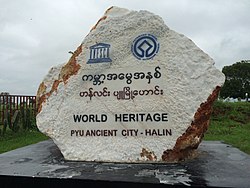Hanlin, Burma
| Hanlin | |
|---|---|
| City | |
 Hanlin – Pyu Ancient City |
|
| Location in Burma | |
| Coordinates: 22°28′54″N 95°48′00″E / 22.48167°N 95.80000°ECoordinates: 22°28′54″N 95°48′00″E / 22.48167°N 95.80000°E | |
| Country |
|
| Region | Sagaing Region |
| District | Shwebo District |
| Township | Hanlin |
| Time zone | MST (UTC+6.30) |
Hanlin (also known as Halingyi, Halin and Halim) is a village near Shwebo in the Sagaing Division of Myanmar. In the era of the Pyu city-states it was a city of considerable significance, possibly a local capital replacing Sri Ksetra. Today the modest village is noted for its hot springs and archaeological sites. Hanlin, Beikthano, and Sri Kestra, the ancient cities of the Pyu Kingdom were built on the irrigated fields of the dry zone of the Ayeyawady River basin. They were inscribed by UNESCO on its List of World Heritage Sites in Southeast Asia in May 2014 for their archaeological heritage traced back more than 1,000 years to between 200 BC and 900 AD.
The archaeological sites of Hanlin, (also known as Halingyi, Halin, and Halim), are located above the village in the Watlet Township, Shwebo District, Sagaing Division. It has a population of about 6,400 (2014). It is 12 miles (19 km) to the southeast of Shwebo where 33 archaeological mound excavations have been carried out. One road goes for 6 miles (9.7 km) from the bus terminal to Bo Te village and then along a rough road which is under improvement. The other route is to the south of the bus station for 6 miles (9.7 km) along a bad, rocky road that leads to archaeological site 29 and the village. The village is slightly above the surrounding flat land. The land is generally barren except for some irrigated areas. Following the inscription of the site on the List of World Heritage Sites, approach road conditions for a distance of 16 kilometres (9.9 mi) from Shwebo to Halin are now under improvement with funding provided by Italy.
Hanlin's history is linked to the history of the Pyu people who lived between the 2nd century BC to the 9th century AD in the kingdoms that existed at Binnaka, Mongamo, Sri Kshetra, and Halingyi. They spoke the Tibeto-Burman languages. Trade was conducted with China and India. The Pyu's authority extended to eighteen kingdoms, most of them in the southern region of Myanmar. They were refined in their behavior, dress habits, culture, art, and were Buddhists of the Sarvastivada school. The architectural styles which evolved from the 11th to 14th centuries are evident in the Pagan area. Initially their capital city was Sri Kshetra, at the northern edge of the Irrawaddy River delta. In the 7th century they moved their capital to Halingyi which is in a dry zone. For trade purposes with foreign countries they still operated from Sri Kshetra. Their southern neighbours were the Mon people who were followers of Theravada Buddhism.
...
Wikipedia

